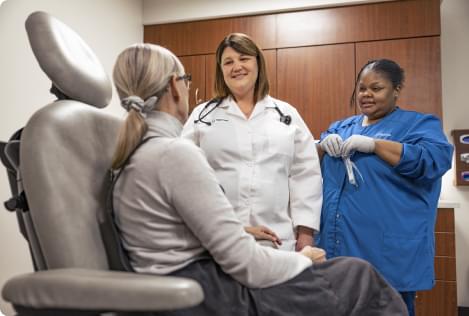Overview
A broken or fractured ankle is an injury to the bone. You may experience a broken ankle from a twisting injury from a simple misstep or fall, or from direct trauma during a car crash, for example.
The seriousness of a broken ankle varies. Fractures can range from tiny cracks in your bones to breaks that pierce your skin.
Treatment for a broken ankle depends on the exact site and severity of the bone fracture. A severely broken ankle may require surgery to implant plates, rods or screws into the broken bone to maintain proper position during healing.

Symptoms
If you have a broken ankle, you may experience some of the following signs and symptoms:
- Immediate, throbbing pain
- Swelling
- Bruising
- Tenderness
- Deformity
- Difficulty or pain with walking or bearing weight
When to see a doctor
See a doctor if there is obvious deformity, if the pain and swelling don't get better with self-care, or if the pain and swelling get worse over time. Also, see a doctor if the injury interferes with walking.
Causes
A broken ankle is usually a result of a twisting injury, but can also be caused by a direct blow to the ankle.
The most common causes of a broken ankle include:
- Car accidents. The crushing injuries common in car accidents may cause breaks that require surgical repair.
- Falls. Tripping and falling can break bones in your ankles, as can landing on your feet after jumping down from just a slight height.
- Missteps. Sometimes just putting your foot down wrong can result in a twisting injury that can cause a broken bone.
Risk factors
You may be at higher risk of a broken ankle if you:
- Participate in high-impact sports. The stresses, direct blows and twisting injuries that occur in sports such as basketball, football, gymnastics, tennis and soccer can cause ankle fractures.
- Use improper technique or sports equipment. Faulty equipment, such as shoes that are too worn or not properly fitted, can contribute to stress fractures and falls. Improper training techniques, such as not warming up and stretching, also can cause ankle injuries.
- Suddenly increase your activity level. Whether you're a trained athlete or someone who's just started exercising, suddenly boosting the frequency or duration of your exercise sessions can increase your risk of a stress fracture.
- Keep your home cluttered or poorly lit. Walking around in a house with too much clutter or too little light may lead to falls and ankle injuries.
- Have certain conditions. Having decreased bone density (osteoporosis) can put you at risk of injuries to your ankle bones.
- Smoking. Cigarette smoking can increase your risk of developing osteoporosis. Studies also show that healing after a fracture may take longer in people who smoke.
Complications
Complications of a broken ankle are uncommon but may include:
- Arthritis. Fractures that extend into the joint can cause arthritis years later. If your ankle starts to hurt long after a break, see your doctor for an evaluation.
- Bone infection (osteomyelitis). If you have an open fracture, meaning one end of the bone protrudes through the skin, your bone may be exposed to bacteria that cause infection.
- Compartment syndrome. This condition can rarely occur with ankle fractures. It causes pain, swelling and sometimes disability in affected muscles of the legs.
- Nerve or blood vessel damage. Trauma to the ankle can injure nerves and blood vessels, sometimes actually tearing them. Seek immediate attention if you notice any numbness or circulation problems. Lack of blood flow can cause a bone to die and collapse.
Prevention
These basic sports and safety tips may help prevent a broken ankle:
- Wear proper shoes. Use hiking shoes on rough terrain. Choose appropriate athletic shoes for your sport.
- Replace athletic shoes regularly. Discard sneakers as soon as the tread or heel wears out or if the shoes are wearing unevenly. If you're a runner, replace your sneakers every 300 to 400 miles.
- Start slowly. That applies to a new fitness program and each individual workout.
- Cross-train. Alternating activities can prevent stress fractures. Rotate running with swimming or biking.
- Build bone strength. Get enough calcium and vitamin D. Calcium-rich foods include milk, yogurt and cheese. Ask your doctor if you need to take vitamin D supplements.
- Declutter your house. Keeping clutter off the floor can help you to avoid trips and falls.
- Strengthen your ankle muscles. If you are prone to twisting your ankle, ask your doctor for exercises to help strengthen the supporting muscles of your ankle.
Diagnosis
Your doctor will examine your ankle to check for points of tenderness. The precise location of your pain can help determine its cause.
Your doctor may move your foot into different positions to check your range of motion. You may be asked to walk for a short distance so that your doctor can examine your gait.
Tests
If your signs and symptoms suggest a break or fracture, your doctor may suggest one or more of the following imaging tests.
- X-rays. Most ankle fractures can be visualized on X-rays. The technician may need to take X-rays from several different angles so that the bone images won't overlap too much. Stress fractures often don't show up on X-rays until the break actually starts healing.
- Bone scan. A bone scan can help your doctor diagnose fractures that don't show up on X-rays. A technician will inject a small amount of radioactive material into a vein. The radioactive material is attracted to your bones, especially the parts of your bones that have been damaged. Damaged areas, including stress fractures, show up as bright spots on the resulting image.
- Computerized tomography (CT). CT takes X-rays from many different angles and combines them to make cross-sectional images of internal structures of your body. CT scans can reveal more detail about the injured bone and the soft tissues that surround it. A CT scan may help your doctor determine the best treatment for your broken ankle.
- Magnetic resonance imaging (MRI). MRI uses radio waves and a strong magnetic field to create very detailed images of the ligaments that help hold your ankle together. This imaging helps to show ligaments and bones and can identify fractures not seen on X-rays.
Treatment
Treatments for a broken ankle will vary, depending on which bone has been broken and the severity of the injury.
Medications
Your doctor may recommend an over-the-counter pain reliever, such as acetaminophen (Tylenol, others).
Therapy
After your bone has healed, you'll probably need to loosen up stiff muscles and ligaments in your ankles and feet. A physical therapist can teach you exercises to improve your flexibility, balance and strength.
Surgical or other procedures
- Reduction. If you have a displaced fracture, meaning the two ends of the fracture are not aligned well, your doctor may need to manipulate the pieces back into their proper positions. This process is called reduction. Depending on the amount of pain and swelling you have, you may need a muscle relaxant, a sedative or a local anesthetic to numb the area before this procedure.
- Immobilization. A broken bone must be immobilized so that it can heal. In most cases, this requires a special boot or a cast.
- Surgery. In some cases, an orthopedic surgeon may need to use pins, plates or screws to maintain proper position of your bones during healing. These materials may be removed after the fracture has healed if they are prominent or painful.
Preparing for your appointment
You will likely initially seek treatment for a broken ankle in an emergency room or urgent care clinic. If the pieces of broken bone aren't lined up properly for healing, you may be referred to a doctor specializing in orthopedic surgery.
What you can do
You may want to write a list that includes:
- Detailed descriptions of your symptoms
- Information about medical problems you've had
- Information about the medical problems of your parents or siblings
- All the medications and dietary supplements you take
- Questions you want to ask the doctor
For a broken ankle, basic questions to ask your doctor include:
- What tests will I need?
- What treatments are available, and which do you recommend?
- If I need a cast, how long will I need to wear it?
- Will I need surgery?
- What activity restrictions will I need to be follow?
- Should I see a specialist?
- What pain medications do you recommend?
Don't hesitate to ask any other questions you have.
What to expect from your doctor
Your doctor may ask some of the following questions:
- Was there a specific injury that triggered your symptoms?
- Did your symptoms come on suddenly?
- Have you injured your ankles in the past?
- Have you recently begun or intensified an exercise program?
What to do in the meantime
If your injury isn't severe enough to warrant a trip to the emergency room, here are some things you can do at home to care for your injury until you can see your doctor:
- Apply ice for 15 to 20 minutes at a time, every three to four hours to bring down the swelling.
- Keep your ankle elevated.
- Don't put any weight on your injured ankle.
- Lightly wrap the injury in a soft bandage that provides slight compression.
© 1998-2024 Mayo Foundation for Medical Education and Research (MFMER). All rights reserved. Terms of Use


